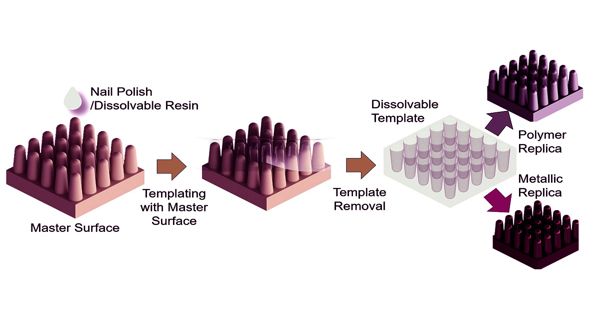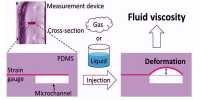Researchers find Cicada-inspired waterproof surfaces nearer to reality
A new fabrication technique allows researchers to replicate the nanostructures of cicada wings. A multidisciplinary group that studies the physical and chemical properties of insect wings has demonstrated the ability to reproduce the nanostructures that help cicada wings repel water and prevent bacteria from establishing on the surface. Researchers who study the physical and chemical properties of insect wings have reproduced the nanostructures that help cicada wings repel water and prevent bacteria from establishing on the surfaces.
The new process allows scientists to work in an open lab at room temperature and atmospheric pressure. They use nail polish and rubbing alcohol, which does not inflict damage to the delicate wing nanostructures, the researchers said.
The technique, resulting from U.S. National Science Foundation-funded research, uses commercial nail polish and is economical and straightforward. The new technique – which uses commercial nail polish – is economical and straightforward, and the researchers said it will help fabricate future high-tech waterproof materials. The scientists said it will help fabricate future high-tech waterproof materials.
The team used a simplified version of a fabrication process called nanoimprinting lithography — to make a template of the complex pillar-shaped nanostructures on the wings of Neotibicen pruinosus, an annual cicada found in the central region of the United States. The templates are fully dissolvable and produce replicas that average 94.4% of the pillar height and 106% of the original wing, or master structure’s pillar diameter, the researchers said.
The results of the study are published in the journal Nano Letters. To show the versatility of the new method, the team experimented with two very different replica materials: copper metal and a flexible silicon-based organic polymer called PDMS.
“We chose to work with wings of this species of cicada because our past work demonstrates how the complex nanostructures on their wings provide an outstanding ability to repel water. That is a highly desirable property that will be useful in many materials engineering applications, from aircraft wings to medical equipment,” said Marianne Alleyne, an entomology professor at the University of Illinois at Urbana-Champaign.
Nanoimprinting lithography is not new but can be labor-intensive and expensive, the researchers said. Some approaches use toxic materials that can damage the original copied object, like a delicate cicada wing. Others require high temperatures that are not compatible with biological samples such as plants or insects.
“Our process allows us to do this in an open lab at room temperature and atmospheric pressure,” Cropek said. “We use nail polish and rubbing alcohol, which does not inflict any damage to the delicate wing nanostructures.”
In the lab, the team applies a quick-drying nail polish directly to a cicada wing, which is then left to cure at room temperature.
To show the versatility of the new method, the team experimented with two very different replica materials: copper metal and a flexible silicon-based organic polymer called PDMS.
“We showed that the technique is compatible with physical vapor deposition and electrochemical deposition of metals, oxides, or ceramics, as well as chemical vapor deposition and spin coating of softer materials like polymers,” Miljkovic said.
“Copper is particularly interesting to us because of its inherent antimicrobial properties, and our past work indicates that some cicada species display antimicrobial properties on their wings,” said Marianne Alleyne, an entomology professor at UI. “We don’t know if it is the chemicals on the wing’s surface or the physical nanostructures, or a combination of both chemistry and topography, that produce the bactericidal activity, but being able to produce materials with different chemistries and structures will help us answer that fundamental question. This new, relatively simple fabrication method will ultimately help us design multifunctional engineered materials,” she said.
















